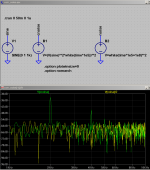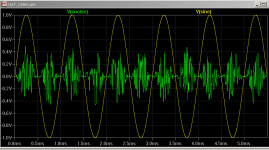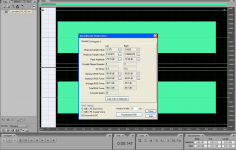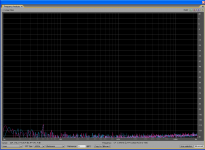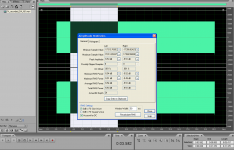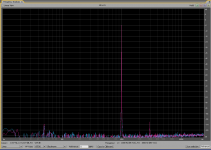I think it was not "Fourier Denial" but the fact that for humans time has a direction.
Uh, sure, right.
Later I will provide details of wire.wav and original.wav run on this similar D/A A/D system with fresh and proper referenced 1kHz.wav:
Barleywater, this is the 1kHz 0dBFs signal replayed through my D/A converter (via foobar) and recorded by my A/D converter. All conditions same as in the test files in this thread, replica of "wire.wav" conditions in fact.
https://www.dropbox.com/s/w9oqvi1w710lux7/1k_recorded_DA_AD.wav
I hope it might help your investigations, probably better than similar file created and recorded on a different D/A - A/D system. We should keep everything as same as possible.
Last edited:
the vague "noise hidden by fft averaging" is lame - fft is in fact an excellent tool for picking out correlations - try the power spectrum
sim shows the clear peaks at 2x the modulation frequency - in the noise Power Spectrum fft (easieist to just square the BV equation)
2nd pane just the modulation and modualted noise - not squared
sim shows the clear peaks at 2x the modulation frequency - in the noise Power Spectrum fft (easieist to just square the BV equation)
2nd pane just the modulation and modualted noise - not squared
Attachments
Last edited:
the vague "noise hidden by fft averaging" is lame
Are you referring to any post here?
It is not a question of hobbyists only, I have never seen any professional method that would reliably and with high resolution measure something that we might call as transient spectrum of non-periodic, non-stationary signal. We all know FFT above single tone, two tones, multitone, noises, frequency/phase responses, impulse responses etc.
None of the measurement is able to provide us with a complex non-linear transfer function with respect to frequency, amplitude, load and input impedance. I would like to see it, once.
None of the measurement is able to provide us with a complex non-linear transfer function with respect to frequency, amplitude, load and input impedance. I would like to see it, once.
This is what I would like to emphasize, jcx. One function that would cover all those variables.
Last edited:
The "simultaneous" requirement is odd- I can measure my car's speed, its length, and its weight. Why would I expect or even want to use a simultaneous single measurement to characterize all of them?
Three dimensionality may be? So we can better visualize and better understand?
Frequency response (FR) is just a line. But create a FR on axis, 5deg, 10deg, 15deg, 20deg, 25deg, 30deg, 35deg, 40deg, 45deg off axis and we get a surface instead of a line. That's how waterfall CSD works. And it's just about time to do it on distortion. (On different point of view, one impulse response might say a lot of things).
I guess this kind of "simultaneous" measurement will be digitally available in ten to twenty years to come, when people start to have a need for it (technically and commercially).
Barleywater, this is the 1kHz 0dBFs signal replayed through my D/A converter (via foobar) and recorded by my A/D converter. All conditions same as in the test files in this thread, replica of "wire.wav" conditions in fact.
https://www.dropbox.com/s/w9oqvi1w710lux7/1k_recorded_DA_AD.wav
Analysis of the initial part, before the 1kHz is turned on, shows overall system noise, both in spectrum and RMS values:
Attachments
Wow. Love the perspective - Epic post!
//
//
Thanks for original.wav.
Yes, caps alone are well modeled, along with resistors and inductors, such that when well employed behave accordingly under analysis. D/A, A/D, recording tape, vinyl recordings are much more difficult entities to model.
Dynamic distortion is good moniker for the multi-headed beast that enables discrimination of single element changes in audio systems.
Dynamic distortions may be categorized roughly in domains of: temporal, frequency, amplitude, and thermal. Simultaneous study is daunting.
Time and relativity. Time for fixed collection of objects viewed from fixed perspective does not exist. Perspective is pure thought, and thoughts require acceptance of existence. We have a very good thought model that can crush the universe into a singularity construct. The singularity is animated with the construction of a time axis. The universe is observed as point by point dilation across time axis.
Fast forward to 21st century Earth. Across the tiny dilation of time taken as our immediate existence, it is viewed as highly linear. Atomic clocks allow mapping of objects considered static from fixed perspective.
The conductor takes the podium. The score and his conception are in his head, stationary and fixed to the audience. There is no music. The conductor shares a common basis with the musicians. The conductor moves and time is created and radiated in a manner perceivable by the musicians. The conductor radiates his conception of the music. The conductor is the primary transducer. The musicians are the secondary transducers. With shared common basis with the conductor for the music, they produce sympathetic vibrations that are coupled to the final voicing transducers, which may be their own bodies, or the bodies of musical instruments. The phenomenon of sound in air is produced and radiates. The radiation encounters both fixed and active transducers, the favorites here being ears and microphones. All the active transducers have a time basis with dilation construct.
Mapping point by point along a dilated time basis is with points as energy amplitude. Energy construct may be substituted with thought, such as complete instances of the universe at moments in time.
Transformations of time and amplitude both held as linear and orthogonal yield the commonly used frequency domain representations.
Much of this depends upon perspective involving time and energy interaction as signal domain and principle of cause and effect of the radiation environment.
Time may be viewed as stationary with energy constant and moving across time. Energy encountering fixed objects along time line react to each object's time domain impedance characteristic. The energy distribution changes. Each new point of the distribution travels along its own time line, with all time lines superimposed upon each other. Mathematically this may be represented as the imaginary time plane or time vector space rooted to real time origin. In constrained physical system this may be seen as reflection, transmission, and radiation from a component in a system conducting time and energy. Radiation as heat may be seen as time vectors with energy points where superposition also holds reference to time origin.
I must take a break now, but leave off with a picture worth a thousand words. It contains information about original.wav, wire.wav, and superposition of a 1kHz.wav from a similar D/A A/D system. Later I will provide details of wire.wav and original.wav run on this similar D/A A/D system with fresh and proper referenced 1kHz.wav:
View attachment 398226
The above does involve other time transformations, and perspectives.
- Status
- This old topic is closed. If you want to reopen this topic, contact a moderator using the "Report Post" button.
- Home
- General Interest
- Everything Else
- Mundorf polyprop x Rodenstein MKT listening test preparation
